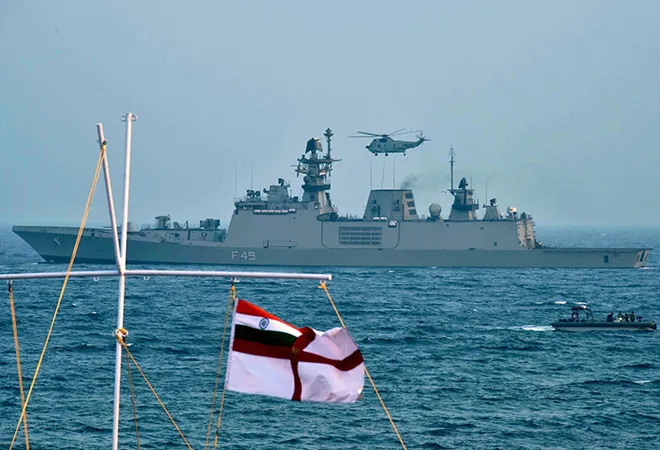
Earlier this week, India
dispatched four naval ships to Maldives and the United Arab Emirates (UAE) as part of an effort to bring back stranded Indians unable to come back due to COVID-19 restrictions. Amphibious vessels INS Jalashwa and INS Magar headed to Maldives while INS Shardul and INS Airavat set sail to the UAE. Fourteen Indian warships have been readied for the task, after the Union Home Ministry announced its intention to bring Indians stuck in various parts of the world back home.
For the record, this is not an ‘
evacuation effort’. While it is being coordinated by the Ministry of External Affairs and Indian missions worldwide, the endeavour is a ‘paid-for’ service, with returning passengers being charged for “mandatory quarantine” facilities and hospitalisation costs. Reportedly, Indian missions in Male and Dubai have opened up booking counters and online registrations for the purpose.
While it is being coordinated by the Ministry of External Affairs and Indian missions worldwide, the endeavour is a ‘paid-for’ service, with returning passengers being charged for “mandatory quarantine” facilities and hospitalisation costs.
Even so, the Indian Navy is likely to treat this as a rescue mission — one Indian warship crews are intimately familiar with. In 2006, an Indian naval taskforce evacuated over 2,000 Indian citizens and foreigners from
Lebanon, in a mission that drew praise from the world. A decade later, in March 2015, Indian warships were in
Yemen rescuing 3,500 Indians in challenging circumstances. The operation was conducted in the middle of a live conflict, with the Saudi-led coalition of Arab states bombing Shiite Houthi rebel targets. Amid strafing and crossfire, Indian sailors battled heavy odds to embark evacuees and successfully complete the mission.
Admittedly, the circumstances this time are different from earlier occasions. Operation ‘
Setu Samudra’ is being carried out in conditions analysts describe as “permissive”, where there is no threat to evacuees or evacuation support personnel and no danger of conditions turning hostile. In fact, countries being visited are likely to fully support the evacuation mission. Yet, naval leaders know that local governments remain in charge of general security, and any law and order complication during the rescue effort could result in unpleasant consequences.
Non-combatant rescues are inherently unpredictable, and rarely follow a set-pattern.
Indian planners would also do well to reflect on some lessons from past missions. First, non-combatant rescues are inherently unpredictable, and rarely follow a set-pattern. There is usually a window of opportunity to execute the mission, beyond which risks multiply and mission feasibility drops appreciably. During Operation Sukoon in 2006, the Navy found itself pushed into
reactive mode, with Indian warships reaching Lebanon only after violence levels had peaked. New Delhi’s tardiness in redirecting Indian warships returning from Greece towards Lebanon delayed start of the operation, even as Israel strengthened its blockade off Lebanon. In the subsequent
Libya rescue in 2011, Indian authorities struggled with executing the evacuation plan in the face of fast-changing conditions on the ground. Similarly, during Operation Rahat in 2015, the intensely hostile conditions in Yemen slowed the rescue effort, as a fierce scramble ensued among evacuees to board Indian warships. Of course, in friendly conditions such as now, this lesson may not matter, but its bottom-line is worth bearing in mind: a non-combatant evacuation depends in large part on the good graces and benevolence of the host state. A high degree of military decorum and diligent action of the part of visiting warships is a must.
Second, non-combatant rescue missions require cooperation between diplomatic and military channels, failing which even well-laid plans often go astray. Indeed, past experience has shown that political sensitivities weigh heavily on a military evacuation initiative and diplomatic procedures are expected to be followed, even when impediments are bureaucratic in nature. During the Lebanon rescue, a sizeable percentage of evacuees were found not to be in
possession of proper documents. It took a good deal of liaison work by naval and embassy officials with local immigration authorities to allow people to board with incomplete documents. This time around, there is another complexity to be addressed. Indian warships are going to be in pandemic affected areas and would need to coordinate with diplomatic missions to ensure all civilians being embarked are free of the COVID-19 virus.
Non-combatant rescue missions require cooperation between diplomatic and military channels, failing which even well-laid plans often go astray.
The possibility of an infected person getting onboard an Indian warship is far from theoretical. It is well known that the pandemic has been spreading through asymptomatic cases, and even one ostensible healthy ‘carrier’ could set off a chain of infections aboard. During the 2006 and 2015 rescue missions, evacuees were accommodated in helicopter hangars, decks, and even the sleeping cabins of sailors. Social distancing wasn’t a priority then, but it is now, and will weigh on the minds of naval planners. In a recent
interview, Vice Admiral Ashok Kumar listed measures the Indian Navy has taken to address the possibility of infection onboard, including the embarkation of medical personnel and the setting up of quarantine facilities both ashore and onboard. Apparently, the Navy had ships’ crews quarantined for a full 14 days before the start of the mission. Yet, with 26 sailors at an Indian
naval base in Mumbai found to have contracted the virus last month, naval managers will be acutely conscious of the challenged involved. The slightest of a slip in handling infected evacuees, they know, could trigger an epidemic outbreak onboard.
A final lesson is that an evacuation mission cannot succeed without robust communication and comprehensive domain awareness. Warships need to be in constant touch with authorities on the ground to inform them of their exact plans for evacuation. Command teams need to monitor changes in the ground situation and adjust plans accordingly — the ultimate aim would be to carry out the rescue mission as smoothly and unobtrusively as possible. All of this would call for unparalleled situational awareness, maintaining a continuous vigil on information sources to build a reliable operational picture that would allow for risk assessment, and a constant liaison with shore authorities to give rescuers a sense of the hazards on the ground.
Notwithstanding the strong humanitarian streak in the Indian navy’s operations philosophy, Indian planners will appreciate risks inherent in operations planned over the next few days. Tact, diplomacy and caution will be the watchwords.
The views expressed above belong to the author(s). ORF research and analyses now available on Telegram! Click here to access our curated content — blogs, longforms and interviews.



 Earlier this week, India
Earlier this week, India  PREV
PREV


